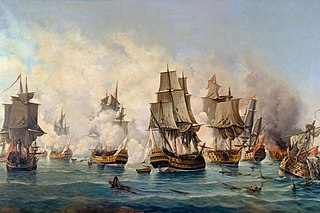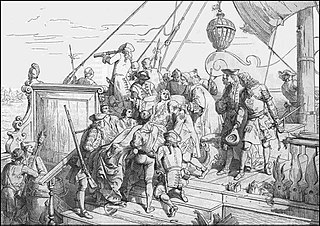The Battle of Andros took place on 22 August 1696 southeast of the Greek island of Andros between the fleets of the Republic of Venice and the Papal States under Bartolomeo Contarini on the one side and the Ottoman Navy, under Mezzo Morto Hüseyin Pasha, and allied Barbary forces on the other. The encounter was indecisive, and no vessels were lost on either side.
There was a series of battles that took place in 1697 when the Venetian fleet, under Bartolomeo Contarini, hunted down the Turkish fleet in the Aegean Sea.

This indecisive naval battle took place on 8 July 1716 during a Turkish attempt to capture the island of Corfu (Kerkyra), off the west coast of mainland Greece.

The Battle of Matapan or the Battle of Cape Matapan took place on 19 July 1717 off the Cape Matapan, on the coast of the Mani Peninsula, now in southern Greece. The naval battle was between the Armada Grossa of the Republic of Venice, supported by a mixed squadron of allied ships from Portugal, the Papal States and Malta, and the Ottoman fleet, under Kapudan Pasha Eğribozlu İbrahim Pasha.

The Battle of Imbros was a naval clash that took place on 12, 13 and 16 June 1717 near Imbros in the Aegean Sea, between the sailing fleets of Venice and the Ottoman Empire. The outnumbered Venetian Armada Grossa, under the Capitano Straordinario delle Navi Lodovico Flangini, proved herself able to match a superior Turkish force under the Kapudan Pasha Hodja Ibrahim Pasha in a manoeuvred fight that lasted nearly ten days. The outcome of this tough battle was unclear, since both fleet retired to their bases badly damaged, after Flangini died of wounds on the 22nd.

Angelo Emo was a Venetian noble, administrator, and admiral. He is notable for his reforms of the Venetian navy and his naval campaigns, being regarded as the last great admiral of the Venetian Republic.

The Seventh Ottoman–Venetian War was fought between the Republic of Venice and the Ottoman Empire between 1714 and 1718. It was the last conflict between the two powers, and ended with an Ottoman victory and the loss of Venice's major possession in the Greek peninsula, the Peloponnese (Morea). Venice was saved from a greater defeat by the intervention of Austria in 1716. The Austrian victories led to the signing of the Treaty of Passarowitz in 1718, which ended the war.

The siege of Corfu took place on 8 July – 21 August 1716, when the Ottoman Empire besieged the city of Corfu, on the namesake island, then held by the Republic of Venice. The siege was part of the Seventh Ottoman–Venetian War, and, coming in the aftermath of the lightning conquest of the Morea by the Ottoman forces in the previous year, was a major success for Venice, representing its last major military success and allowing it to preserve its rule over the Ionian Islands.

The Leon Trionfante-class were a class of at least fourteen 70-gun third rate ships of the line built by the Venetian Arsenale from 1716 to 1785, in four different series with minor changes in the ships' length. In 1797, when Venice fell to the French, Napoleon captured several ships of the class, still unfinished in the Arsenal: he chose one of them, forced the shipbuilders to have it completed and added it to his fleet en route for Egypt. After Campoformio, the remaining vessels were destroyed by the French to avoid their capture by the Austrian Empire.
The San Carlo Borromeo-class ships of the line were a class of two 66-gun third rates built by the Venetian Arsenal from 1750 to 1793.
The San Lorenzo Zustinian class were a class of at least twenty-nine 70-gun third rate ships of the line built by the Venetian Arsenale from 1691 to 1746, in three different series with minor changes in the ships' length. It was the most numerous class of ship of the line built in Venice, and the last to see active service in a war against the Ottoman Empire in 1718. All this class' ships were planned before 1720, and the vast majority was launched before the Peace of Passarowitz. The last four vessels were completed to 70% in 1720s, then stored in the roofed shipbuilding docks of the Arsenale to be finished and launched between 1739 and 1746, a solution that was widely used with the following Leon Trionfante-class.

Andrea Pisani was a Venetian noble who served as Captain General of the Sea during the Seventh Ottoman–Venetian War.

Lodovico Flangini was a Venetian noble who served as Capitano Straordinario delle Navi during the Seventh Ottoman–Venetian War.
This is an alphabetical index of people, places, things, and concepts related to or originating from the Republic of Venice. Feel free to add more, and create missing pages.
The Giove Fulminante class were the first class of first-rate ships of the line built by the Venetian Arsenal, from 1666 to 1691, armed with 62 to 68 guns. The fifth ship of the class was extensively modified during construction and became the lead ship of the following San Lorenzo Zustinian class. The last ship of the class was retired in 1709.










